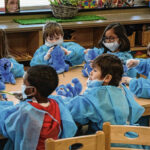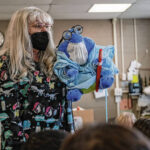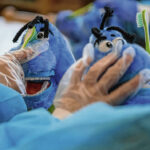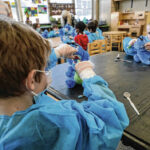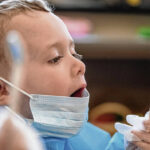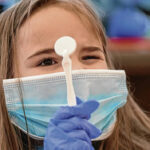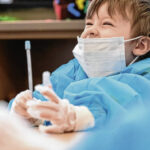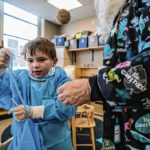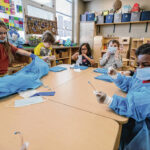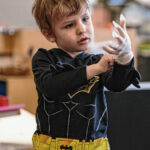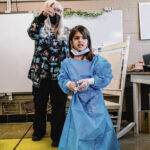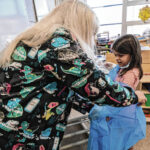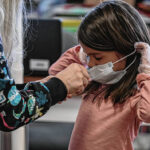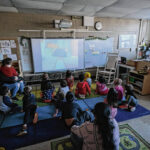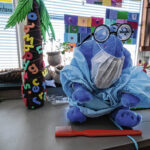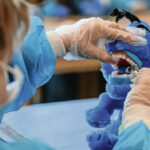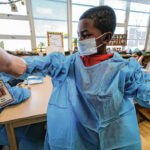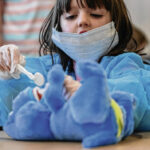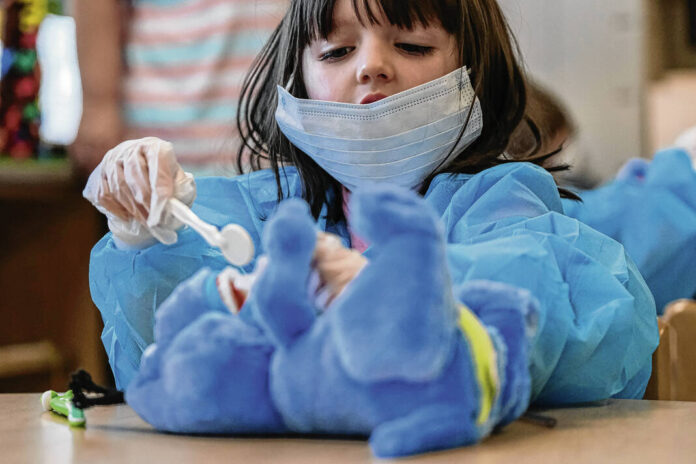
Mike Wolanin | The Republic Zoey Burris uses a dental mirror to examine the teeth of her dinosaur dental patient during a “Dress Like a Dentist” event at Busy Bees Academy in Columbus, Ind., Friday, Feb. 24, 2023. The Bartholomew County Health Department put on the event to promote good dental hygiene and what to expect during a dentist appointment.
A group of preschoolers recently brushed up on the basics of dental care and check-ups — thanks to a little help from the local tooth fairy and her dinosaur friends.
Bartholomew County Health Department Dental Coordinator Colleen Ferry Sullivan, aka “the Tooth Ferry,” visited Busy Bees Academy on Feb. 24 to teach students about dental hygiene with some memorable methods — including checking stuffed dinosaurs for cavities and introducing the class to her colleague, a dinosaur puppet named Dr. Flossasauris.
After showing the students the short animated film, “Dudley Visits the Dentist,” Sullivan demonstrated how to dress like a dentist by helping one child put on a mask, gloves and dental gown.
“When you get your patients, be gentle,” Sullivan advised the class, as she helped 5-year-old Anna Ryshavy suit up. “They’re only 1-year-old dinosaurs. And today, you’re going to be Dr. Anna.”
The other students then donned their own dental apparel with help from Sullivan and other adults. Next, the newly-minted dentists used toothbrushes and dental instruments to inspect and clean the teeth of stuffed dinosaurs, with Sullivan and Dr. Flossasauris offering words of encouragement and advice.
Anna, for one, said she would like to be a dentist and had fun brushing her patient’s teeth and counting them.
“Your teeth are nice and shiny,” she told the dino, before reminding it to brush twice daily.
Once the check-ups were finished, Sullivan taught the students a song, reminding them to brush their teeth twice daily for two minutes each time and visit the dentist twice a year. Students also received a “Dinosaur Dentist Certificate” and dental bags.
Friday’s Busy Bees visit was just one of several “Dress Like a Dentist” events held by the county health department during February, which was National Children’s Dental Health Month. These events are also part of Indiana’s Give Kids A Smile activities and the county health department’s efforts to provide dental health education to children.
Sullivan estimated that she has taught about 500 children about dental care in February, including roughly 40 at Busy Bees.
“The main goal of this program is getting them comfortable with the dentist’s office,” she said.
She also noted that many people haven’t gotten back into the routine of going to the dentist following the pandemic.
The county health department is emphasizing the importance of good dental habits, as well as the seriousness of tooth decay. According to a 2010 Public Health Report by then-U.S. Surgeon General Regina Benjamin, dental decay is the most common chronic disease in children, being five times as common as asthma and seven times as common as hay fever.
“The most common cause of tooth loss among adults is untreated periodontal (gum) disease,” wrote Benjamin. “Fifty-three million people live with untreated tooth decay in their permanent teeth. Strikingly, one-quarter of adults aged 65 years and older have lost all of their teeth due to untreated oral disease.”
When asked why some people are afraid of dental visits, Sullivan said that parents are sometimes worried, which could be due to past experiences.
However, as she recently told a group of first-graders, if things do go wrong, “The dentist is there to make you feel better.”
For a video, click the URL code below:
Mike Wolanin | The Republic Busy Bees Students practice proper brushing habits on their t-rex patients in a “Dress Like a Dentist” event at Busy Bees Academy in Columbus, Ind., Friday, Feb. 24, 2023. The Bartholomew County Health Department put on the event to promote good dental hygiene and what to expect during a dentist appointment.
Mike Wolanin | The Republic Bartholomew County Health Department Dental Coordinator Colleen Ferry Sullivan, also knows at the Tooth-Ferry, uses a stuffed dinosaur named Dr. Flossasauris to teach children proper brushing habits in a “Dress Like a Dentist” event at Busy Bees Academy in Columbus, Ind., Friday, Feb. 24, 2023. The Bartholomew County Health Department put on the event to promote good dental hygiene and what to expect during a dentist appointment.
Mike Wolanin | The Republic Busy Bees students examine and brush the teeth of their dinosaur dental patients during a “Dress Like a Dentist” event at Busy Bees Academy in Columbus, Ind., Friday, Feb. 24, 2023. The Bartholomew County Health Department put on the event to promote good dental hygiene and what to expect during a dentist appointment.
Mike Wolanin | The Republic Mason Branum, left, and Connor Buchannan examine the teeth of their dinosaur dental patients during a “Dress Like a Dentist” event at Busy Bees Academy in Columbus, Ind., Friday, Feb. 24, 2023. The Bartholomew County Health Department put on the event to promote good dental hygiene and what to expect during a dentist appointment.
Mike Wolanin | The Republic Lincoln Elliott checks his teeth in a dental mirror during a “Dress Like a Dentist” event at Busy Bees Academy in Columbus, Ind., Friday, Feb. 24, 2023. The Bartholomew County Health Department put on the event to promote good dental hygiene and what to expect during a dentist appointment.
Mike Wolanin | The Republic Nadia Loveland looks at her reflection in a dental mirror during a “Dress Like a Dentist” event at Busy Bees Academy in Columbus, Ind., Friday, Feb. 24, 2023. The Bartholomew County Health Department put on the event to promote good dental hygiene and what to expect during a dentist appointment.
Mike Wolanin | The Republic Leo Rackmann smiles as he wears his dentist gear during a “Dress Like a Dentist” event at Busy Bees Academy in Columbus, Ind., Friday, Feb. 24, 2023. The Bartholomew County Health Department put on the event to promote good dental hygiene and what to expect during a dentist appointment.
Mike Wolanin | The Republic Jackson Kistler puts on a protective gown to take part in a “Dress Like a Dentist” event at Busy Bees Academy in Columbus, Ind., Friday, Feb. 24, 2023. The Bartholomew County Health Department put on the event to promote good dental hygiene and what to expect during a dentist appointment.
Mike Wolanin | The Republic Busy Bees students put on protective clothing to take part in a “Dress Like a Dentist” event at Busy Bees Academy in Columbus, Ind., Friday, Feb. 24, 2023. The Bartholomew County Health Department put on the event to promote good dental hygiene and what to expect during a dentist appointment.
Mike Wolanin | The Republic Mason Branum puts on protective gloves to take part in a “Dress Like a Dentist” event at Busy Bees Academy in Columbus, Ind., Friday, Feb. 24, 2023. The Bartholomew County Health Department put on the event to promote good dental hygiene and what to expect during a dentist appointment.
Mike Wolanin | The Republic Bartholomew County Health Department Dental Coordinator Colleen Ferry Sullivan, also knows at the Tooth-Ferry, shows Anna Ryshavy where to sit to take part in a “Dress Like a Dentist” event at Busy Bees Academy in Columbus, Ind., Friday, Feb. 24, 2023. The Bartholomew County Health Department put on the event to promote good dental hygiene and what to expect during a dentist appointment.
Mike Wolanin | The Republic Bartholomew County Health Department Dental Coordinator Colleen Ferry Sullivan, also knows at the Tooth-Ferry, helps Anna Ryshavy don a protective gown as she takes part in a “Dress Like a Dentist” event at Busy Bees Academy in Columbus, Ind., Friday, Feb. 24, 2023. The Bartholomew County Health Department put on the event to promote good dental hygiene and what to expect during a dentist appointment.
Mike Wolanin | The Republic Bartholomew County Health Department Dental Coordinator Colleen Ferry Sullivan, also knows at the Tooth-Ferry, helps Anna Ryshavy put on a face mask as she takes part in a “Dress Like a Dentist” event at Busy Bees Academy in Columbus, Ind., Friday, Feb. 24, 2023. The Bartholomew County Health Department put on the event to promote good dental hygiene and what to expect during a dentist appointment.
Mike Wolanin | The Republic Busy Bees students watch a video about practicing good dental hygiene during a “Dress Like a Dentist” event at Busy Bees Academy in Columbus, Ind., Friday, Feb. 24, 2023. The Bartholomew County Health Department put on the event to promote good dental hygiene and what to expect during a dentist appointment.
Mike Wolanin | The Republic A stuffed dinosaur named Dr. Flossasauris sits on a table at before being used to help preschool students practice good dental hygiene during a “Dress Like a Dentist” event at Busy Bees Academy in Columbus, Ind., Friday, Feb. 24, 2023. The Bartholomew County Health Department put on the event to promote good dental hygiene and what to expect during a dentist appointment.
Mike Wolanin | The Republic Mason Branum examines the teeth of his T-Rex dental patient during a “Dress Like a Dentist” event at Busy Bees Academy in Columbus, Ind., Friday, Feb. 24, 2023. The Bartholomew County Health Department put on the event to promote good dental hygiene and what to expect during a dentist appointment.
Mike Wolanin | The Republic Noah McClackion puts on protective gear to take part in a “Dress Like a Dentist” event at Busy Bees Academy in Columbus, Ind., Friday, Feb. 24, 2023. The Bartholomew County Health Department put on the event to promote good dental hygiene and what to expect during a dentist appointment.
Mike Wolanin | The Republic Zoey Burris uses a dental mirror to examine the teeth of her dinosaur dental patient during a “Dress Like a Dentist” event at Busy Bees Academy in Columbus, Ind., Friday, Feb. 24, 2023. The Bartholomew County Health Department put on the event to promote good dental hygiene and what to expect during a dentist appointment.
